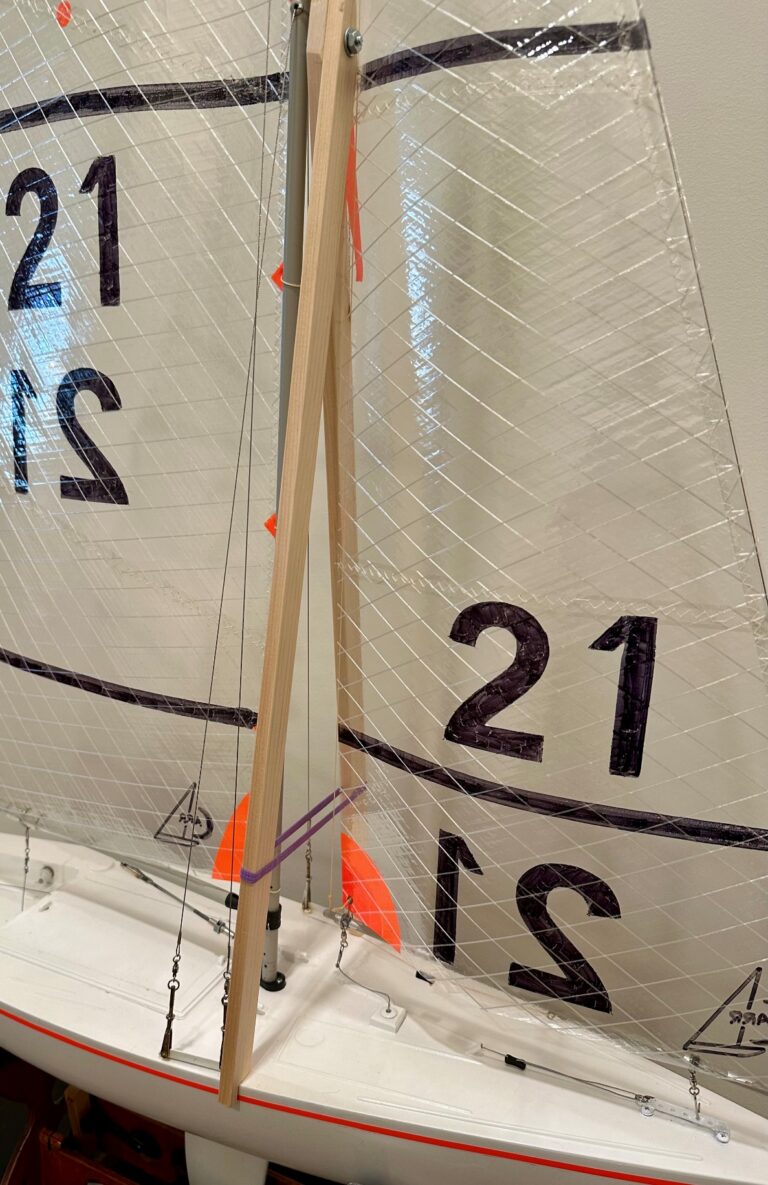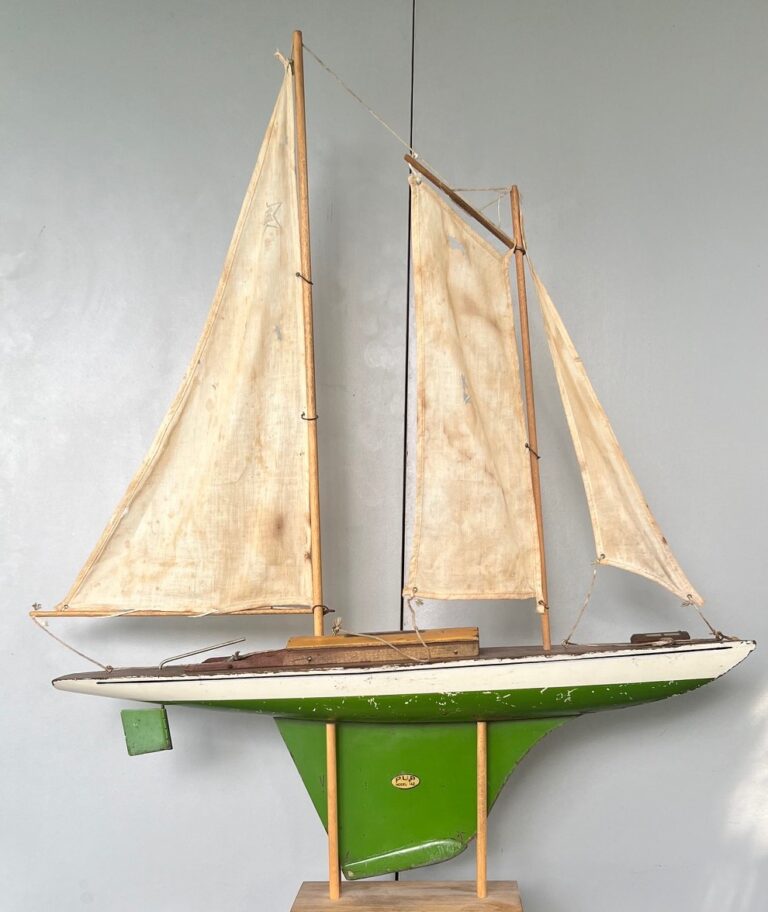by Charlie Roden
As promised in our last issue, changes in the Vintage Marblehead Rating Rules will be considered at this time. Before discussing the proposed changes, however, it is useful to consider the goals of our vintage activities and of the VM Model Group, in particular, as they have a large bearing on the rules that we adopt.
Our founders envisioned a vintage group of sailors that would not be interested in serious competition, but would rather be attracted to the history, building, static display and fun racing of early sailing models. The program was envisioned as being as inclusive as possible in order to encourage both the novice and long-time sailor, as well as the builder and non-builder. Emphasis was to be placed on replicating the beautiful form of these early models with as few limits on construction methods and materials used as possible. If it looks like a VM from ten paces, then it is a VM. Leave as much to the ingenuity and creativity of the builder as possible.
Life, however, is more complex than any of us would at first admit. An early decision was made to allow the use of modern materials in order to permit the building of stronger hulls with simpler, faster construction techniques. Fiberglass hulls were allowed in order to include existing fiberglass vintage models and to leave the door open for the availability of vintage kits for those who are not interested in building from scratch. The only restriction on fiberglass is that a molded fiberglass hull must be comparable in weight to a similar hull constructed of wood. Exotic materials including kevlar, carbon fiber, and mylar were not allowed because of their cost and the desire to avoid the technology race of the modern M class. Early vintage racing showed that we needed to address the disparity in performance of forty years of design evolution of the Marblehead development class. Two divisions were formed to establish racing groups of more comparable performance: Traditional (1945 and before) and High Flyer (1946 through 1970). It was realized that the additional rules defining each of the two classes were loose and would never completely level the playing field. However, it was believed that racing in separate divisions would narrow the performance differences and when combined with the range of skill levels of vintage sailors and the variation in sailing conditions at any site would make our racing of these boats interesting. Racing is only one element of our annual regattas which include static judging, sailing demonstrations, visits to nearby model manufacturers and hardware vendors, and most of all social gatherings including the imbibing of fine food and spirits. Winners are not enshrined in the Sailing Hall of Fame.
Well, why even consider any further changes at this point? The only reason that I can think of is that we are newly formed and a few changes at this time might make vintage racing at our regattas more equitable and fun. Having said that, the VM Design Committee, which is responsible for approving changes, wishes to involve VM owners in the decision making process. A simple majority vote by registered VM owners will gain acceptance of changes that have received prior approval by the Design Committee as being based on valid assumptions and consistent with our goals. Approval by the Design Committee is not necessarily a recommendation for a vote of acceptance by owners. A proposed change that does not receive the approval of the Design Committee, may still gain acceptance by receiving at least a 2/3 majority vote of all registered VM owners. The proposed changes submitted by VM owners at this time are listed below. All registered VM owners are invited to respond by submitting a vote of yes or no on each proposed change by postal mail or e-mail to me.
1. Proposed Change: Sail luff measurement shall be from the bottom of the tack to a point at the head where the width of the sail perpendicular to the luff measures 3/4 inch.
Discussion:
The 1954 rules call for the luff measurement to be from the sail tack to the bottom of the headboard or headstick or eye (where no headboard or headstick is used). The headboard at its base cannot exceed a width of 3/4 inch. Modern materials have allowed the use of thin flexible materials or in many cases just an additional layer of cloth for a headboard. There is confusion as to whether an additional layer of cloth constitutes a headboard or a strengthening patch. There is also no requirement on the placement of the eye. This change would avoid this confusion and require measurement to a 3/4 inch width point at the head of the sail in all cases without regard to the existence or non-existence of a headboard. Strengthening patches may be extended below the 3/4 inch width point of the sail, but it should be appreciated that they stiffen and flatten the sail thereby reducing its aerodynamic shape and drive. This problem was more fully discussed in the Vol. 3 No.1 Spring 1999 issue.
Approved by the VM Design Committee.
2. Proposed Change: Multi-paneled sails may be used in both Divisions.
Discussion:
Multi-paneled sails were not disallowed in the 1939 or 1954 M rules. Unlike the construction of sails on full-size boats where no practical choice existed, paneled sails were avoided in models because of sail cloth limitations. With modern materials this is no longer the case and paneled sails would offer improved performance particularly in light air. This would add to the fun of sailing vintage models. While a single panel sail is easy to make, it is not easy to make a good single panel sail because of the difficulty of controlling small amounts of luff round. Their construction is further complicated by cloth variations from bolt to bolt and variations in the bend characteristics of wooden masts. Some feel that a good set of multi-paneled sails, however, are within the reach of novice builders. Several AMYA articles exist that show how to construct a camber shaped block to aid in making the broad seams that add curvature to a sail. Those who opposed this change last year have had a change of heart and requested that this change be reconsidered.
Approved by the VM Design Committee.
3. Proposed Change: Traditional Division rules shall be based on modifications of the 1939 M Rules.
Discussion:
The present rules for both Divisions are based on the 1954 M Rules. The 1939 rules cover the Traditional period. The only difference between the two sets of rules is that the sail luff measurement in the 1939 Rules is from the top of the boom as contrasted to from the bottom of the sail tack in the 1954 rules.
Approved by the Design Committee.
4. Proposed Change: The height of the mast above the deck in the Traditional Division shall not exceed 70 inches.
Discussion:
The Traditional Marbleheaders are characterized by low aspect ratio sail forms. A draft limit of 12 inches in the present rules was intended to discourage the use of tall rigs. This certainly works in moderate and heavy air, but less so in very light air conditions. The 70 inch mast limit will further safeguard against the use of tall rigs.
Not approved by the Design Committee (no mast height limit in the early rules, further constraints discourage participation).
5. Proposed Change: Only a single set of sails may be used in a given regatta in both Divisions.
Discussion:
This restriction would avoid the added complexity and cost of the use of multiple sails to take advantage of the varying wind conditions at a regatta.
Not approved by the Design Committee (alternate rigs have always been allowed to cover the full range of wind conditions).
6. Proposed Change: All materials other than brass are prohibited for fittings and other metal gear, except shrouds and stays for the Traditional VM.
Discussion:
While other materials were used during this period, brass was primarily used.
Not approved by the Design Committee (many different materials were used for fittings on early models).
7. Proposed Change: For the Traditional Division the maximum draft allowed is 11.5 inches
Discussion:
The present limit is 12 inches. The new proposed limit is closer to the deepest boat known in this class. This would reduce the likelihood that existing boats would be outclassed by new deeper draft boats.
Not approved by the Design Committee (some early 1930s boats believed to have exceeded this limit and tweaking discourages participation).
8. Proposed Change: Eliminate aluminum as a mast and boom material for the Traditional VM
Discussion:
While some may have experimented with aluminum during this period, wood was almost exclusively used.
Not approved by the Design Committee (aluminum masts not uncommon, don’t want to discourage ease of construction).
9. Proposed Change: Exclude balsa planking method of hull construction for the Traditional Division
Discussion:
This is to encourage traditional wood construction and avoid the possibility of producing a hull that is lighter than one constructed by traditional methods.
Not approved by the Design Committee (don’t want to limit construction alternatives further, already limit on fiberglass hull weight).



